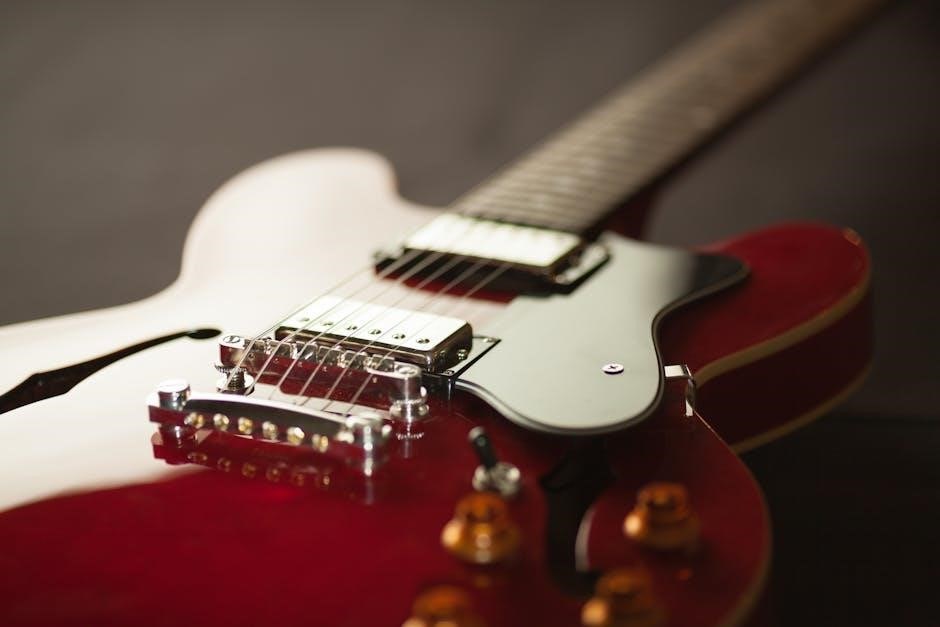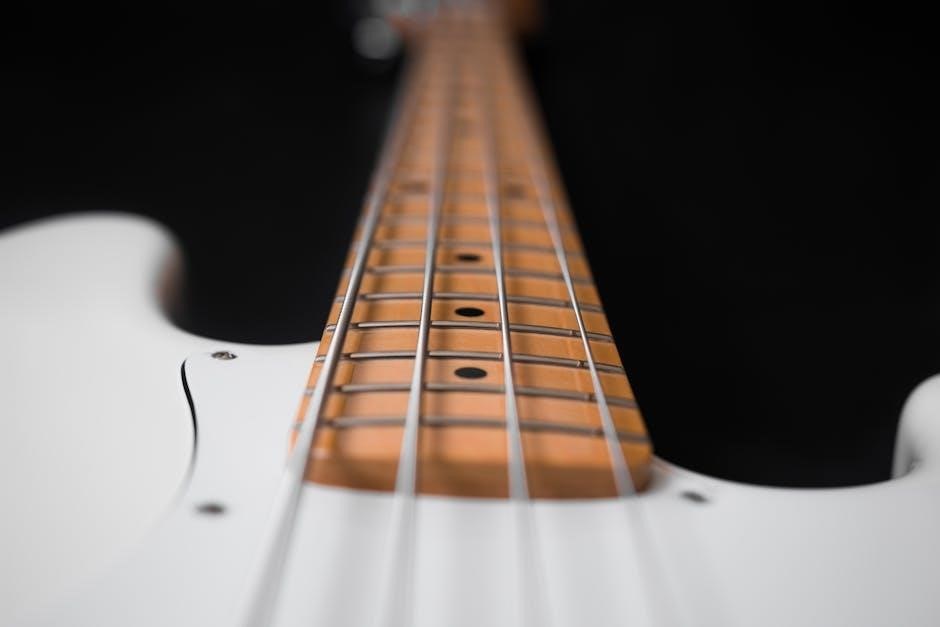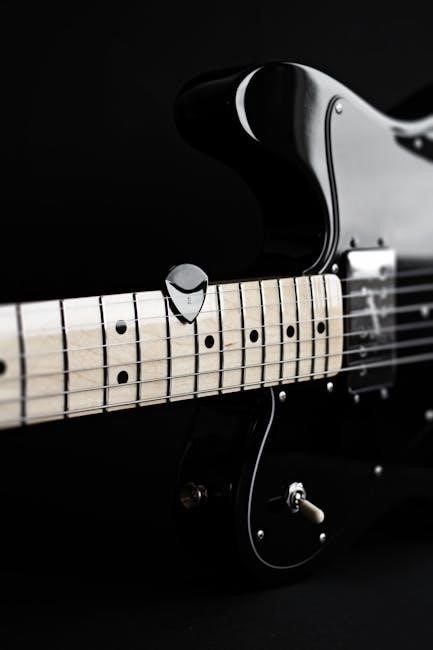Welcome to the world of jazz guitar chords! These chords are essential for creating rich, complex harmonies in jazz music. From major and minor to dominant, half-diminished, and altered voicings, jazz chords offer a vast palette of sounds. Whether you’re a beginner or an advanced player, mastering these chords will elevate your musical expression and open doors to improvisation and composition. Explore the fundamentals, common voicings, and advanced techniques to unlock the full potential of jazz guitar.
What Are Jazz Chords?
Jazz chords are extended versions of basic chords, incorporating additional intervals like 7ths, 9ths, 11ths, and 13ths to create richer, more complex harmonies. These chords often include altered tones, such as flat or sharp 5ths, 9ths, and 11ths, to add depth and color. Common types include major, minor, dominant, and diminished chords, each with variations that suit different musical contexts. They are essential for improvisation and comping in jazz, offering a wide range of tonal possibilities for expressive playing.
Importance of Jazz Chords in Guitar Music
Jazz chords are fundamental to creating the harmonic richness and complexity that define jazz music. They enable guitarists to express nuanced emotions and intricate melodies, making them indispensable for both improvisation and composition. By mastering these chords, players can enhance their ability to comp behind soloists and add depth to their own solos. The versatility of jazz chords also makes them applicable across various genres, from blues to fusion, ensuring their relevance in modern guitar music and beyond.
Basic Concepts for Beginners
Mastering jazz chords begins with understanding the basics. Start by learning root notes, intervals, and chord structures, which form the foundation of harmony. Familiarize yourself with chord symbols and how they translate to the fretboard. Practice simple voicings, focusing on major, minor, and dominant chords, before progressing to more complex shapes. Developing finger independence and a systematic approach to chord charts will streamline your learning process. Building a strong technical and theoretical base ensures steady progress in jazz guitar, even for those new to the genre.

Types of Jazz Guitar Chords
Jazz guitar chords encompass a variety of voicings, including major, minor, dominant, half-diminished, diminished, and altered chords, each offering unique harmonic possibilities for musical expression.
Major Jazz Chords
Major jazz chords are foundational in jazz music, providing a bright, uplifting sound. They typically consist of a root, major third, and perfect fifth, often extended with sevenths, ninths, or elevenths for added richness. For instance, a Cmaj7 chord includes notes C, E, G, and B. These chords are versatile, commonly used in jazz standards and progressions, such as the 2-5-1 sequence. Learning major jazz chords is essential for building a solid harmonic foundation and expanding your musical vocabulary as a guitarist;
Minor Jazz Chords
Minor jazz chords evoke a rich, melancholic sound, often used in jazz standards and improvisation. They typically include a root, minor third, and perfect fifth, with extensions like sevenths, ninths, or elevenths. For example, a Dm7 chord comprises D, F, A, and C. These chords are versatile, appearing in various progressions, such as the 2-5-1 sequence. Practicing minor jazz chords helps build emotional depth and versatility in your playing, essential for capturing the complexity of jazz harmony and expanding your musical expression.
Dominant Jazz Chords
Dominant jazz chords are foundational in jazz harmony, often functioning as tension builders. They typically include a root, major third, perfect fifth, and minor seventh, with optional extensions like ninths or elevenths. For example, a G7 chord comprises G, B, D, and F. Altered dominants, such as G7alt, add flatted or sharpened thirds or sevenths, enhancing harmonic complexity. These chords are crucial in progressions like the 2-5-1, offering dynamic movement and emotional depth, making them indispensable for jazz guitarists aiming to create compelling solos and accompaniments.
Half-Diminished and Diminished Jazz Chords
Half-diminished and diminished chords add unique colors to jazz harmony. A half-diminished chord (e.g., Dm7b5) features a minor third, diminished fifth, and minor seventh, often used in modal interchange. Diminished chords (e.g., Cdim7) include two minor thirds and a diminished fifth, creating tension. Both are frequently used in jazz standards and progressions, offering rich harmonic possibilities. Mastering these chords enhances your ability to play complex, emotionally engaging jazz lines, making them essential for any serious jazz guitarist.
Altered Jazz Chords
Altered jazz chords introduce tension by modifying the 5th, 7th, 9th, or 11th intervals. Common alterations include flat 9th, sharp 9th, flat 5th, and sharp 5th, adding harmonic richness. Often used in dominant contexts, these chords create dramatic, emotionally charged sounds. For example, a C7alt chord (C-E-Bb-Db) adds a flat 9th for a darker tone. Mastering altered chords is essential for advanced jazz playing, as they enhance harmonic complexity and expand your musical expression. They are particularly useful in improvisation and complex chord progressions, offering a sophisticated palette of sounds for the modern jazz guitarist.

Common Jazz Guitar Chords for Beginners
Start with essential jazz chords like Cmaj7, Am7, Dm7, and E7. These versatile voicings are foundational for jazz guitar, allowing you to play common progressions and standards effectively.
Essential Voicings for Starting Jazz Guitarists
Mastering essential jazz chord voicings is crucial for beginners. Start with basic shapes like Cmaj7, Am7, Dm7, and E7. These voicings form the foundation of jazz harmony and can be moved across the fretboard to create various chords; Focus on root-based chords to build familiarity with the neck. Practice these shapes in different keys to develop flexibility and a strong harmonic understanding. These voicings will help you navigate common jazz progressions and lay the groundwork for more complex chords.
How to Read and Play Chord Diagrams
Learning to read jazz chord diagrams is key to mastering voicings. Chord diagrams show the guitar neck, with dots indicating which frets to press. Numbers represent fingers, and open strings are played without pressing. Start with common voicings like Cmaj7 and Am7, focusing on clean tones. Practice aligning your fingers directly behind the fret for clarity. Mute unnecessary strings to avoid dissonance. These diagrams are essential for applying chords to jazz standards and building a solid harmonic foundation. Regular practice will enhance your ability to interpret and play complex voicings.
Basic Chord Progressions to Practice
Mastering basic jazz chord progressions is crucial for building a strong foundation. Start with simple 2-5-1 sequences, such as Dm7-G7-Cmaj7, and gradually explore more complex patterns. Practice ii-V-I progressions in various keys to enhance harmonic understanding. Begin with slow tempos, focusing on smooth transitions and clean tones. These exercises improve finger dexterity and familiarity with chord shapes. Regular practice of these progressions will help you develop muscle memory and prepare you for more intricate jazz compositions and improvisations.

Jazz Guitar Chord Progressions
Jazz guitar chord progressions form the harmonic foundation of jazz music. Common progressions include ii-V-I, 2-5-1, and 3-6-2-5 sequences. These patterns are versatile and widely used across various jazz styles, from bebop to Latin jazz. Practicing these progressions in different keys and tempos enhances your harmonic understanding and improvisational skills. They provide a structured framework for exploring complex harmonies and creating cohesive musical narratives; Mastering these progressions is essential for every aspiring jazz guitarist.
The 2-5-1 Progression in Jazz
The 2-5-1 progression is a cornerstone of jazz harmony, commonly used in standards and improvisation. It consists of a ii chord, a V chord, and a I chord, creating a harmonic resolution. For example, in C Major, it would be Dm7 ⸺ G7 ⸺ Cmaj7; This progression is versatile, allowing for substitutions and alterations to add complexity. Regular practice in various keys enhances fluency and understanding of jazz harmony. It serves as a foundational tool for both comping and soloing, making it a must-learn for all jazz guitarists.
Understanding Key Signatures and Chord Function
Key signatures and chord function are fundamental to jazz harmony. A key signature defines the tonal center, while chord function explains how chords relate within that key. Tonic, dominant, and subdominant functions guide harmonic movement. For example, in C Major, Dm7 is the ii chord, G7 is the V, and Cmaj7 is the I. Understanding these relationships helps in learning progressions and improvising. Free PDF charts and method books provide extensive resources to master these concepts, essential for every jazz guitarist aiming to build a strong harmonic foundation.
Practicing Comping with Jazz Chords
Comping, short for accompanying, is a vital skill in jazz guitar. It involves playing chords that support the rhythm section while creating harmonic interest. Start with simple voicings in common keys, focusing on timing and feel. Use metronomes to improve syncopation and dynamics. Practice over standards and backing tracks to adapt to different tempos and styles. Free PDF guides and method books offer exercises and examples to refine your comping technique, helping you become a versatile and expressive jazz accompanist.

Advanced Jazz Guitar Chord Techniques
Explore advanced techniques like drop 2 and drop 3 voicings, shell chords, and altered dominants. These methods enhance harmonic depth and versatility, perfect for improvisation and complex compositions.
Drop 2 and Drop 3 Voicings
Drop 2 and Drop 3 voicings are essential advanced techniques in jazz guitar. These involve altering chord shapes by “dropping” the second or third highest note, creating richer, more complex sounds. These voicings are widely used in jazz for their harmonic depth and versatility. By applying these techniques, guitarists can achieve a fuller, more sophisticated sound, ideal for both comping and soloing. These voicings are particularly effective in improvisation and complex compositions, allowing for greater expressiveness and musicality.
Shell Chords and Their Applications
Shell chords are simplified, three-note voicings focusing on the root, third, and seventh. These minimalistic chords are ideal for clear harmonic expression and rhythmic precision; Often used in bebop and hard bop, shell chords provide a strong harmonic foundation while leaving room for improvisation. They are particularly effective in fast tempos and complex changes, allowing guitarists to maintain clarity and drive. Shell chords are also versatile, applicable in both comping and melodic lines, making them a cornerstone of modern jazz guitar technique and a powerful tool for musical expression.
Using Altered Dominants in Jazz
Altered dominant chords add rich, complex harmonies to jazz music. By modifying extensions like the 9th, 11th, or 13th through raising or lowering, these chords create unique tensions. The altered scale, with its flattened and raised notes, aligns with these chords, enhancing their expressive qualities. Using altered dominants in progressions like ii-V-I can heighten dramatic effect, making resolutions more impactful. Experimenting with different alterations helps tailor the mood, from dissonant blues feels to exotic tensions. Regular practice, ear training, and studying resources are key to mastering their application, ensuring they enrich your musical expression effectively.

Learning Resources for Jazz Guitar Chords
Discover comprehensive resources for mastering jazz guitar chords. Free PDF charts, online courses, and method books offer diverse learning tools. Explore chord diagrams, exercises, and practical applications to enhance your skills effectively.
Free PDF Chord Charts and Diagrams
Enhance your jazz guitar journey with free PDF resources. These downloadable charts and diagrams provide detailed chord shapes, voicings, and exercises. From major and minor chords to altered dominants, these guides cover essential jazz harmony. Many PDFs include practical applications, such as chord progressions and arpeggio studies. They are perfect for beginners and advanced players alike, offering a clear visual approach to mastering jazz guitar chords. Explore these tools to deepen your understanding and improve your playing.
- Chord diagrams for common jazz voicings.
- Exercises for building chord vocabulary.
- Practical applications for improvisation.
Online Courses and Tutorials
Online courses and tutorials are excellent resources for mastering jazz guitar chords. These structured programs offer video lessons, interactive tools, and comprehensive guides tailored to all skill levels. From foundational chord voicings to advanced techniques, these courses provide step-by-step instruction. Many include practical exercises, backing tracks, and real-world applications, ensuring you can apply what you learn to actual jazz standards. They’re ideal for those seeking a guided learning experience to refine their jazz guitar skills.
- Structured lessons for all skill levels.
- Video tutorials and interactive tools.
- Practical exercises and real-world applications.
Recommended Method Books for Jazz Guitar
Method books are indispensable for systematic learning of jazz guitar chords. Titles like The Jazz Guitar Chord Bible Complete offer comprehensive guides to three- and four-string voicings, covering passing, altered, and logical chord shapes. These books often include scale diagrams, arpeggio patterns, and exercises to build a strong foundation. Many are available as downloadable PDFs, making them accessible for practice and reference. They are tailored for both teachers and students, ensuring a structured approach to mastering jazz guitar techniques.

Practicing Jazz Guitar Chords
Regular practice is key to mastering jazz guitar chords. Start with essential exercises to build chord vocabulary, then apply them to jazz standards. Use PDF resources for structured learning and audio files for real-time application, ensuring a smooth transition from theory to performance.
Exercises for Building Chord Vocabulary
Building a strong jazz guitar chord vocabulary requires consistent practice. Start with basic exercises like chord shapes, arpeggios, and scales to develop finger strength and familiarity. Use PDF chord charts to explore major, minor, dominant, and altered chords. Practice switching between chords smoothly in different keys to improve dexterity. Incorporate real-world applications by playing over jazz standards, focusing on comping rhythms. Record yourself to track progress and refine your technique. Regular practice will help you master complex voicings and apply them confidently in performances.
How to Apply Chords to Jazz Standards
Mastering jazz guitar chords is pointless without applying them to real music. Start by learning chord progressions of popular jazz standards, such as “Summertime” or “Blue Bossa.” Use PDF chord charts to identify chord voicings and substitutions. Begin with simple tunes, focusing on smooth transitions and rhythmic accuracy. Gradually explore more complex standards, experimenting with altered and extended chords. Listen to recordings of jazz legends to understand how they use chords creatively. Practice improvising over changes to develop your own style and build confidence in your playing.
Ear Training and Improvisation Tips
Ear training is crucial for mastering jazz guitar chords and improvisation. Start by transcribing solos and identifying chord tones in your favorite jazz standards. Practice singing or humming intervals and scales to develop pitch recognition. Use PDF chord charts to map out harmonic structures, then apply them over backing tracks; Focus on arpeggios and melodic patterns to create coherent lines. Experiment with substitutions and extensions to expand your harmonic vocabulary. Record yourself to track progress and refine your musicality.

The 2-5-1 Progression in Depth
The 2-5-1 progression is a cornerstone of jazz harmony, offering rich harmonic movement. PDF resources provide comprehensive guides to exploring and mastering this essential chord sequence.
Understanding the 2-5-1 Chord Sequence
The 2-5-1 chord sequence is a fundamental harmonic framework in jazz, creating a sense of resolution and tension. It typically consists of a supertonic (2nd), dominant (5th), and tonic (1st) chord within a key. PDF guides offer detailed diagrams and exercises to help guitarists master this progression, emphasizing root movements and voice leading. Practicing in various keys enhances versatility, while exploring substitutions and alterations expands harmonic possibilities, making it a cornerstone of jazz improvisation and composition.
Practicing the 2-5-1 in Different Keys
Mastering the 2-5-1 progression in various keys is essential for jazz guitarists, as it enhances versatility and harmonic understanding; PDF guides often include exercises starting on different strings, promoting finger independence and familiarity across the fretboard. By exploring major and minor variations, players can adapt to diverse musical contexts. Regular practice in all keys strengthens chord vocabulary and prepares guitarists for improvisation and comping in dynamic jazz settings, ensuring a solid foundation for advanced techniques like substitutions and alterations.
Common Variations and Substitutions
Jazz guitarists often explore variations and substitutions to add complexity and color to progressions. Altered dominants, modal interchange, and reharmonization are popular techniques. For instance, substituting a dominant chord with an altered version or using diminished chords creates tension and release. PDF guides provide exercises and examples, such as replacing a 5-1 resolution with a 5-alt-1-7 progression. These substitutions expand harmonic possibilities, allowing musicians to craft unique and engaging solos while maintaining harmonic integrity and emotional depth in their playing.

Using Arpeggios in Jazz Guitar
Arpeggios in jazz guitar involve playing chords as flowing, melodic lines, enhancing solos and chord progressions. They connect chords seamlessly, adding harmonic depth and color to improvisations.
What Are Arpeggios and How to Play Them
An arpeggio is a musical technique where the notes of a chord are played in succession, rather than simultaneously. In jazz guitar, arpeggios are used to create smooth, melodic lines that outline chord progressions. They can be based on various chord types, such as major, minor, dominant, and altered chords, each corresponding to specific harmonic contexts.
To play arpeggios, guitarists typically use specific fingerings and patterns that allow them to navigate the fretboard efficiently. Practicing arpeggios involves breaking down chords into their individual notes and playing them in a flowing sequence. This technique not only enhances solos but also provides a deeper connection to the harmonic structure of the music.
Arpeggios are often used in improvisation and chord melodies to add complexity and interest. By practicing arpeggios in different keys and over common progressions like the 2-5-1, guitarists can develop a more sophisticated and expressive sound. Starting with basic major and minor arpeggios and gradually incorporating more complex ones, such as dominant and altered, can build a strong foundation for jazz playing.
Arpeggio Patterns for Jazz Chords
Arpeggio patterns for jazz chords involve playing the notes of a chord in a smooth, sequential manner. Common patterns include major, minor, dominant, and altered arpeggios, each tailored to specific harmonic contexts. These patterns are often used over chord progressions like the 2-5-1, where they outline the underlying harmony. Guitarists can use scales, modes, and chord tones to create intricate arpeggio lines. Practicing arpeggios in different keys and tempos helps build fluency and enhances improvisational skills. Start with slower tempos and gradually increase speed for mastery.
- Focus on major and minor arpeggios first.
- Experiment with dominant and altered patterns.
- Apply arpeggios over common jazz progressions.
Integrating Arpeggios into Your Playing
Integrating arpeggios into your playing enhances both rhythm and lead techniques. Start by practicing arpeggios over common jazz progressions like the 2-5-1, using backing tracks to simulate real-world scenarios. Focus on smooth transitions and musical phrasing. Combine arpeggios with scales for richer solos, and experiment with rhythmic variations. Avoid mechanical playing by emphasizing melody and feel. Regular practice will help arpeggios become a natural part of your improvisational and compositional toolkit.
- Start with slower tempos and build speed gradually.
- Use arpeggios to outline chord changes clearly.
- Blend arpeggios with scale passages for variety.

Walking Bass Lines and Chords
Walking bass lines combined with chords create a dynamic, rhythmic foundation in jazz. This technique involves playing a melodic bass line while harmonizing with chords, enhancing both rhythm and harmony. Regular practice and a strong understanding of chord progressions are essential for mastery. Use arpeggios and chordal tones to connect lines smoothly, ensuring a cohesive sound. This approach is vital for accompaniment and improvisation, bridging rhythm and melody effectively in jazz guitar playing.
Combining Chords with Walking Bass
Combining chords with walking bass lines is a fundamental technique in jazz guitar, blending harmonic and rhythmic elements seamlessly. By integrating chord voicings with a melodic bass line, players create a dynamic foundation that enhances both rhythm and harmony. This method requires precision in timing and a deep understanding of chord progressions. Regular practice with scales, arpeggios, and chordal tones helps develop smooth transitions. Start with slower tempos and gradually increase speed, focusing on clarity and balance between chords and bass lines. This approach not only strengthens your accompaniment skills but also opens doors to more complex improvisational techniques, making it a cornerstone of jazz guitar mastery.
Practicing Walking Bass Lines
Practicing walking bass lines is crucial for developing a strong rhythmic and harmonic foundation in jazz guitar. Start by playing slow tempos, focusing on smooth transitions between notes. Use scales, arpeggios, and chord tones to create melodic bass lines that align with chord progressions. Emphasize timing and tone quality, gradually increasing speed as confidence grows. Regular practice with metronomes and backing tracks helps build consistency. This technique enhances your ability to accompany and improvise, making it a vital skill for any jazz guitarist aiming to master complex harmonies and rhythms seamlessly.
Advanced Techniques for Combining Chords and Bass
Advanced techniques for combining chords and bass involve intricate fingerstyle arrangements and polyphonic playing. Learn to simultaneously play melody, harmony, and bass lines, creating a full, layered sound. Use chord inversions and substitutions to enhance harmonic depth. Experiment with drop-2 and drop-3 voicings for a richer texture. Incorporate arpeggios and scales to add melodic interest. Practice complex time signatures and syncopation to build rhythmic sophistication. These techniques require precision and control, offering a rewarding way to explore jazz guitar’s expressive potential in both solo and ensemble settings, ensuring a nuanced and dynamic performance every time.
Jazz Guitar Chord Scales
Jazz guitar chord scales are essential for building complex harmonies and melodies. Explore the melodic minor, harmonic minor, and major scales to craft rich, expressive chord voicings and solos.
Melodic Minor and Harmonic Minor Scales
The melodic minor and harmonic minor scales are fundamental in jazz guitar. The melodic minor scale is used for creating tension and resolution, while the harmonic minor adds exotic flavors. Both scales are essential for constructing jazz chords and improvising over complex progressions. By mastering these scales, guitarists can unlock advanced voicings and solos, enhancing their musical versatility and depth.
Using Scales to Build Chords
Understanding how scales build chords is key to mastering jazz guitar. Scales provide the intervals and notes needed to construct chords. For example, the melodic minor scale is rich in extended chord tones like 7ths, 9ths, and 11ths, while the harmonic minor scale adds unique, exotic flavors. By learning these scales, guitarists can identify chord tones and extensions, enabling them to craft complex jazz chords and improvise effectively over chord progressions. This relationship between scales and chords is foundational for advanced jazz guitar playing.
Practical Applications of Chord Scales
Chord scales are invaluable for jazz guitarists, offering a bridge between harmony and melody. By applying scales like the melodic minor and harmonic minor, players can create intricate chord voicings and solos. These scales also aid in improvisation, allowing guitarists to navigate complex chord progressions with ease. For instance, the harmonic minor scale adds unique, exotic tones to dominant chords, while the melodic minor scale enhances major and minor chords with extended intervals. This approach is essential for crafting compelling jazz guitar lines and harmonies.
Mastery of jazz guitar chords requires dedication and practice. With resources like PDF chord charts and method books, you can refine your skills. Remember, consistent practice and creativity are key to unlocking the full potential of jazz guitar. Keep exploring and learning to achieve musical excellence.
Final Tips for Mastering Jazz Guitar Chords
Mastering jazz guitar chords requires consistent practice and a structured approach. Start with essential voicings like major, minor, and dominant chords, gradually incorporating advanced techniques such as drop 2/3 and shell chords. Use PDF chord charts to visualize shapes and build a strong foundation. Practice regularly, applying chords to standards and improvising over progressions. Explore altered dominants and arpeggios to enhance your harmonic vocabulary. Stay motivated, and remember, mastery is a lifelong journey of discovery and creativity in jazz guitar.
Resources for Continued Learning
Enhance your jazz guitar journey with diverse learning resources. Free PDF chord charts and diagrams offer visual guides for mastering voicings. Online courses and tutorials provide structured lessons, while method books like The Jazz Guitar Chord Bible delve into advanced techniques. Explore websites offering downloadable materials, such as arpeggio studies and chord progressions. Utilize instructional videos and printable eBooks to deepen your understanding. These tools will help you build a robust jazz guitar foundation and continue growing as a musician.
Encouragement and Motivation for Practice
Consistent practice is key to mastering jazz guitar chords. Celebrate small victories, like learning a new voicing or smoothly navigating a progression. Set achievable goals and track your progress. Remember, mastery takes time, but each step brings you closer to your musical aspirations. Stay inspired by listening to jazz legends and exploring new tunes. Embrace challenges as opportunities to grow. With dedication and passion, you’ll unlock the rich harmonic world of jazz guitar and enjoy the rewarding journey of continuous improvement.

